OVERVIEW
Now that you have established if owning chickens is right for you, how, where and how many chickens you can house, which breed you want and the age. It is time to look at what it takes to care for your flock.
Your birds are going to require quite a bit of your daily attention for their care and wellbeing.
TAKING CARE OF YOUR FLOCK
Your birds are going to require quite a bit of your daily attention for their care and wellbeing.
Keeping your bird(s) healthy
Vaccinations
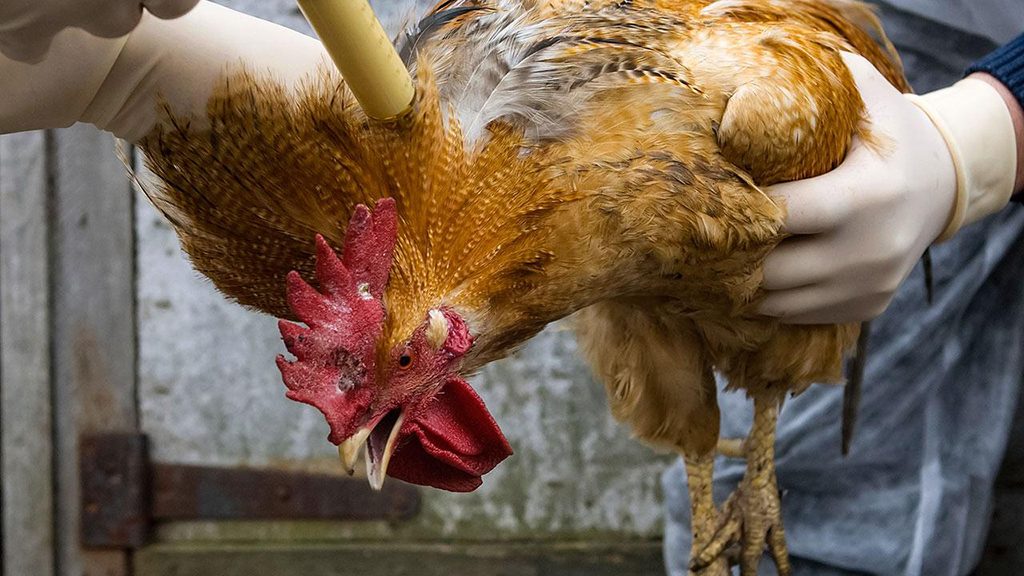
Before you buy your chickens, it is advisable to ask the supplier what the birds have been vaccinated against.
If your chickens are going to be mixing with other livestock or domestic animals, it is advisable to have them vaccinated against Marek’s disease.
It is also advisable to check with your local vet, animal shelter and or animal welfare society about vaccinations for your bird(s).
Prevention is always better than cure so if you can prevent a disease it is better to do so especially if it is prolific in your area.
Chickens are also prone to not showing they are sick until it is too late. They will act as normal as possible as not to be bullied by the rest of the flock.
You can administer most vaccinations by yourself, but it is better to let a vet or someone proficient in animal husbandry to do.
Make sure you keep the vaccinations up-to-date.
De-worming

All animals that are kept domestically or on a farm should be dewormed at regular intervals. Especially as these pests can spread at an alarmingly fast rate to infect your flock.
Prevention/Treating worms:
There are various methods to do this, but it is always best to check with your vet for the best one for your flock.
They will also best advise you on how often and the best way in which to administer the medication to them.
Over the counter solutions:
One of the easiest and most cost-effective ways, it cost around $20, is the liquid de-wormer.
You put the required amount in their drinking water about once a month.
Natural remedies:
There are also more natural remedies that you can do throughout the month which will also help get rid of any existing worms and even some other pest like sand mites and ticks.
You can try crushing up some garlic with their feed or giving the pumpkin seeds and even Apple Cider vinegar will do the trick.
Severe cases:
In severe cases, it is always best to take the animal to the vet and ensure you get the proper treatment to treat the rest of your flock.
A worm outbreak:
If your flock is getting worms it is best to ensure that any other animals around them are also de-wormed.
Make sure the ground that they are walking on, foraging in, etc. is also worm free.
The surrounding:
There are products that can sanitize the ground to ensure the worms are killed.
Keeping the grass short will help the suns rays to kill any leftover parasitic eggs that may still be in the grass.
There are chemicals such as Soubenol, Flubenvet and other herbal treatments one can get from your local vet or veterinary suppliers.
Symptoms of worms:
It is not easy to tell if your bird(s) have worms but in the initial stages, they may go off to lay eggs in unusual places.
They may have diarrhoea – with some worms you will be able to see them in the chicken’s droppings
They may eat more
They may lose a lot of weight
And if they have gapeworm will stretch their necks as if they are gasping for air
Severe infestations can be fatal to the bird(s)
Types of worms:
Tapeworm
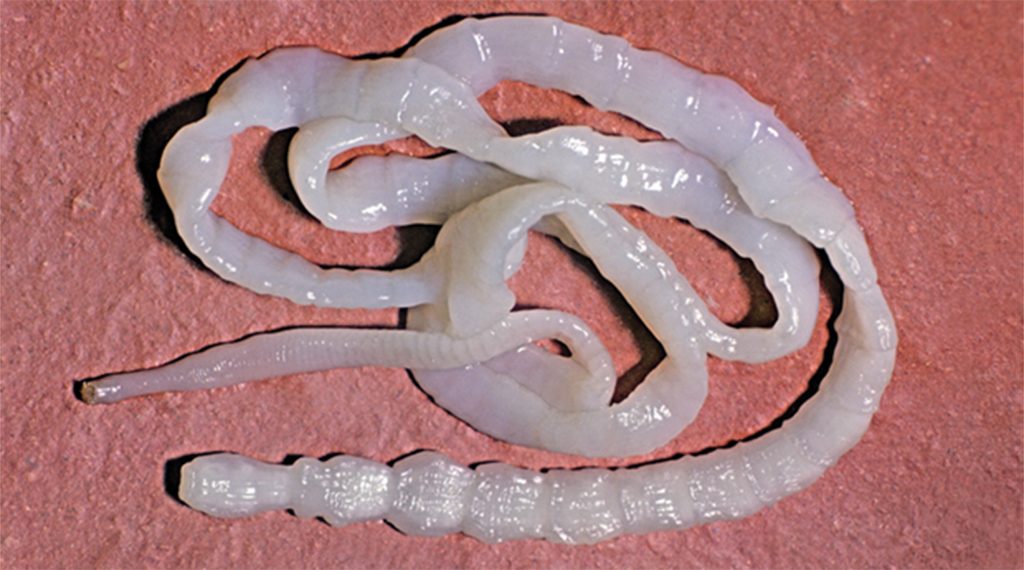
this is not that common but can occur and will weaken the bird(s) immune system as they attach themselves to the birds intestine lining.You will need to take them to the vet to determine if they do have a tapeworm and the best treatment for this.
Gapeworm
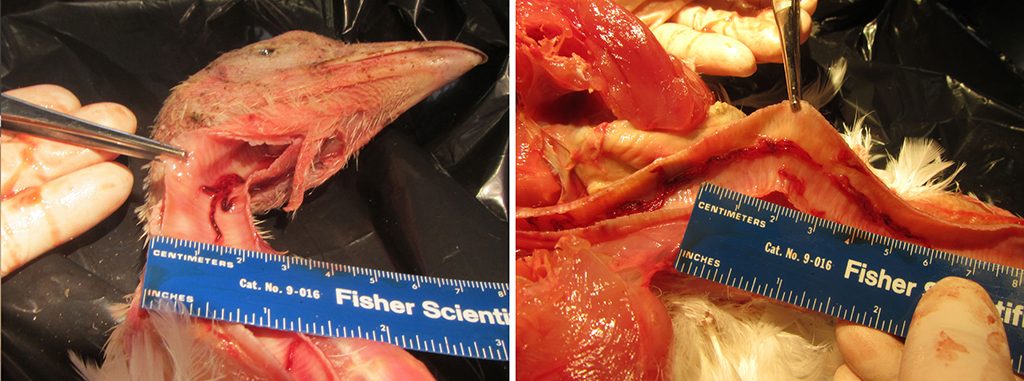
these nasty worms attach themselves to the bird(s) trachea and is why they make the bird stretch out their necks and appear as if they are gasping for air. These worms are more common in chickens as they can be picked up from hosts such as snails, slugs and worms.
Roundworm
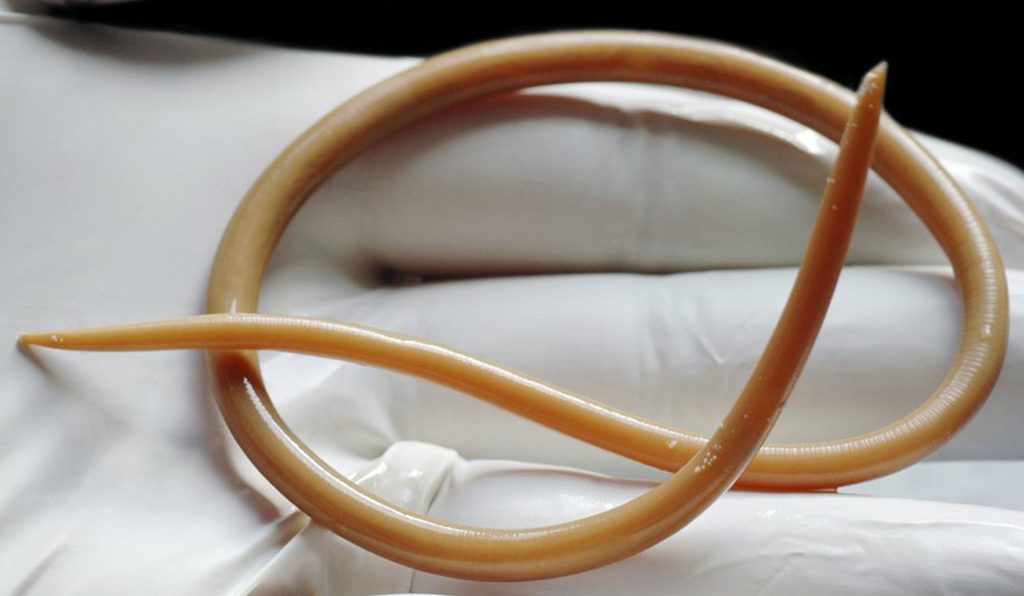
there are a few types of these worms with the large roundworm being the most common of them. They will basically take up anywhere in the bird(s) digestive system. These you may be able to pick up in your bird’s droppings.
Pest-free
There are other forms of pests besides worms that can affect your flock.
These are quite common and can occur even with regular care of your coop/run. Fleas love the warm weather and can be quite a nuisance in the summertime especially in the hotter climates.
Prevention/Treating fleas, mites and lice:
Cleaning and treating the coop, run, garden areas and other domestic animals they may come into contact regularly is a must.
Check your birds often by checking through their feathers close to their skin particularly on their breast, tail and vent areas.
Some mites will get between the scaly parts of the chicken’s legs.
If they have one of these parasites they can be treated by various solutions depending on the parasite.
Over the counter solutions:
There are over the counter remedies you can get any store or vet clinic.
Always read and follow the instructions if you are not sure to seek advice from your local vet or animal shelter.
Ensure that the areas in and around the coop or wherever the chickens roam has been treated.
Natural remedies:
There are garlic sprays available or a person can make their own by:
Crushing 3 x whole cloves of garlic in 2 cups of water
You can also add a teaspoon of lavender, spearmint, thyme, bay or cinnamon oil to the mix.
Spray you chickens, coop, run and various places around the coop.
You can even add crushed garlic to their water or dry feed.
Severe cases:
In severe cases, it is always best to take the animal to the vet some flea species live near the chicken’s eyes and a severe infestation of these can lead to blindness. If the chicken is in severe discomfort it is best to get the infestation treated by the vet.
A pest outbreak: :
If one bird has fleas it is almost definite that the rest of your flock has too. Each bird must get treated, their coop completely cleaned, treated as with the surrounding areas.
Ensure all your domestic animals are treated as well.
Once you have cleaned the coop make sure you take off any shoes, gloves, etc. before you enter your home. These should be soaked and cleaned accordingly as you do not want to traipse them into your home.
The surrounding: :
Make sure you keep your grass short as these pests tend to thrive in longer grass.
There are both chemical and natural treatments for the garden to get rid of pests.
Symptoms of pests such as mites, fleas and lice: :
These three pests tend to display the same signs of infestation. Your birds will display the following most common symptoms that they may be irritated by these parasites:
Discomfort and blood loss
Decrease egg production
Continuous scratching
Irritability
General malaise
Ratelessness
See feathers deteriorate in patches and have raw skin spots
Some infestations can cause blindness and even death
The pests that you may encounter with your bird(s) are: :
Mites:

These creepy little red critters are distantly related to non-other than the spider.
They come in three varieties too:
Northern Fowl Mite :
they love to live in the vent region of the coop but are quite happy to live on the chicken as well.
Red Mite :
these are the peskiest of the mites and once there is an infestation are really difficult to get rid of. You may even need to get in a professional pest control to get rid of them. They love to live in the nesting boxes and other nooks and crannies of the coop. They will feed on the chicken’s blood during the night.
Scaly-leg Mite :
these horrid little critters live in the scaly parts of the chicken’s leg. This can make the bird go lame if not treated in time. They will make the chicken’s leg become thick, rough and inflamed.
Lice:
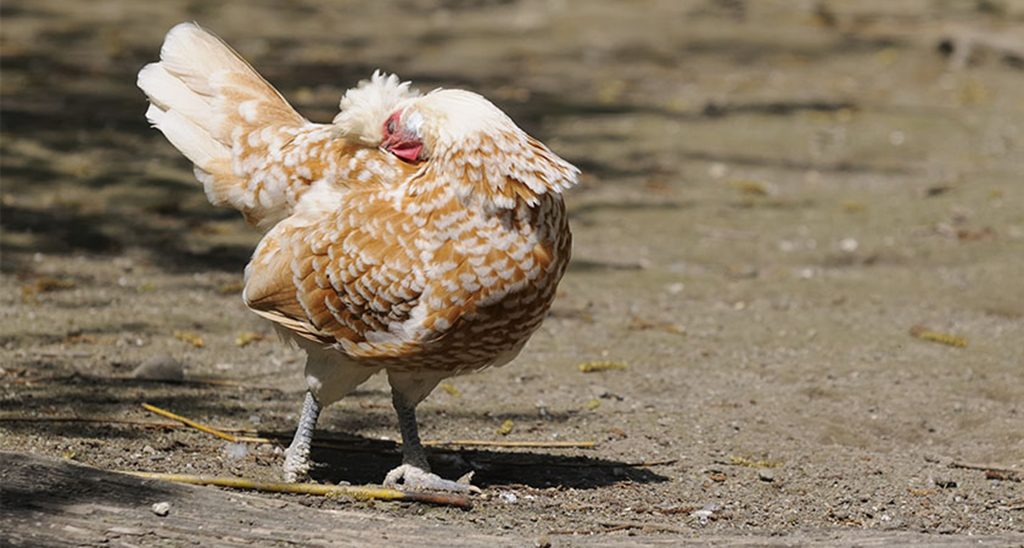
These pesky critters will chew on the chicken’s feathers and skin flakes. They are highly annoying to the chicken and lay their eggs at the base of the feathers. Some cases are so severe the bird is unable to preen the eggs of them.
There are around 50 different species of lice that can be found on chickens. Ask your local poultry adviser for more in-depth information on these.
Fleas
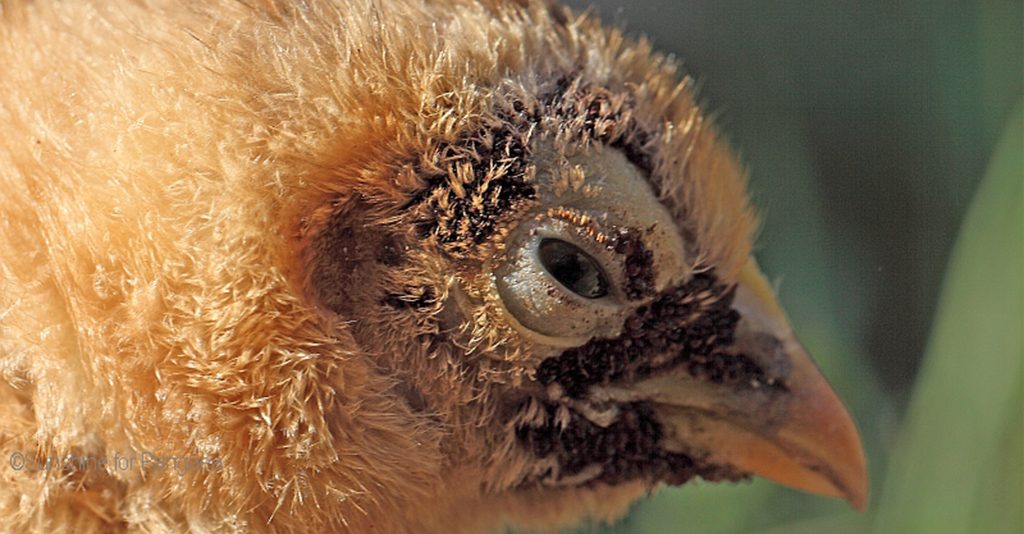
Most chicken fleas that you can see only represent about 5% of what is actually on the animal. The other 95% or the flea population exists on the bird in either larvae or egg form.
Fleas can survive in the long grass for a short period of time but need to have a host to survive. They live on the bird and tend to breed rather rapidly once they are being fed well.
Try sprinkling FGDE on the coop floor, nesting boxes, roosting areas and it can also be dusted on your flock (always check instructions before applying).
Although garlic is excellent as a general deterrent for most pests and worms there is a possibility it could Heinz Anemia. This is because garlic is part of the onion family. Onion is not a recommended food source for your birds.
Apple Cider Vinegar sprayed lightly on your flock feathers as well as certain herbs such as mint will keep them away.
Ticks

Poultry ticks are sneaky critters that you may not find on the bird itself. That is because they hide out in the coop during the day to feed on their host at night.
These ticks are actually carried by wild birds and are very common in nests such as vultures, buzzard, egrets, etc.
They live in the dark crevices between the wood slats of the coop or in cracks in the wood.
They love the heat, damp and moist weather. Although the very cold weather will kill them it is best to keep your coop tick free no matter the season.
The scary thing about Poultry ticks is that they can survive without feeding of up to 4 years.
Effect on the flock
There are many severe diseases that these critters can cause including and ascending paralysis of the leg, wing and raspatory system. They can cause the bird severe anaemia, depression and weight loss.
Signs and symptoms of poultry ticks:
Agitated birds at night time
They may pace and not want to into the coop
They may become aggressive
General malaise in the bird(s)
Reduced egg production
Treatment:
There are over the counter remedies one can get at your local animal clinic or live poultry supplier.
If your local animal shelter keeps chickens, they will be able to help you with the remedy.
As ticks can have some nasty side effects if you have had a Poultry tick outbreak it is best to get your flock/bird(s) looked over by the vet.
De-tick the coop
Remove all the birds from the coop.
It may be best practice to set them up a clean temporary home for a day or two.
Remove all the nesting boxes, water, food bowls and if you can their roosting posts.
Use the solution you have bought and scrub out the coop, nesting boxes and roosting posts with it.
Use a high-pressure hose to blast out the coop, nesting boxes and clean down the roosting posts.
If there are gaps between your boards it may be best to close these up using caulk once the coop has dried out.
If your nesting boxes are also made from wood boards that do have joins, caulk them too.
These ticks like to live and breed between boards, knots in the wood and tiny crack or crevice they can find.
Once the coop has been cleaned, your birds have been treated you can let them back in the coop.
Once you have had one infestation it is best to always check for them every time you clean out your coop.
Grooming
Although most chickens do not require a lot of grooming they still like to keep their feather well preened and healthy.
Show birds do require extra maintenance and care, even a bath! Your regular gals can also be bathed on occasion.
Bathing your chickens

Sometimes you may need to bath your hen(s) this is like bathing most any other pet.
You will need a basin large enough to comfortably dip the bird into.
Fill the basin with luke-warm water. You can put some soap suds in the tub, any baby shampoo or mild soap.
Or you can gently apply the soap to their feathers.
Ensure you hold her gently but firmly and you do not distress her too much.
Once you have soaped her make sure you rinse all the soap off her feathers.
Some people go all out and give their hens a nice blow dry with a warm to cool hair dryer.
Clipping nails

Most chicken’s nails are worn down naturally by their foraging and scratching about. But there are occasions or breeds that will need to be cut, or the nail gets too long, curls and can cause health issues for the bird.
If you are not comfortable doing this, you could ask your local vet or live poultry supplier to help out.
If you are comfortable to do it, then you will need a dog nail clipper.
Clip the nail taking care not to clip it too short or clip the pinkish part of their nail (the quick) this will cause it to bleed and will hurt the bird.
Clipping wings
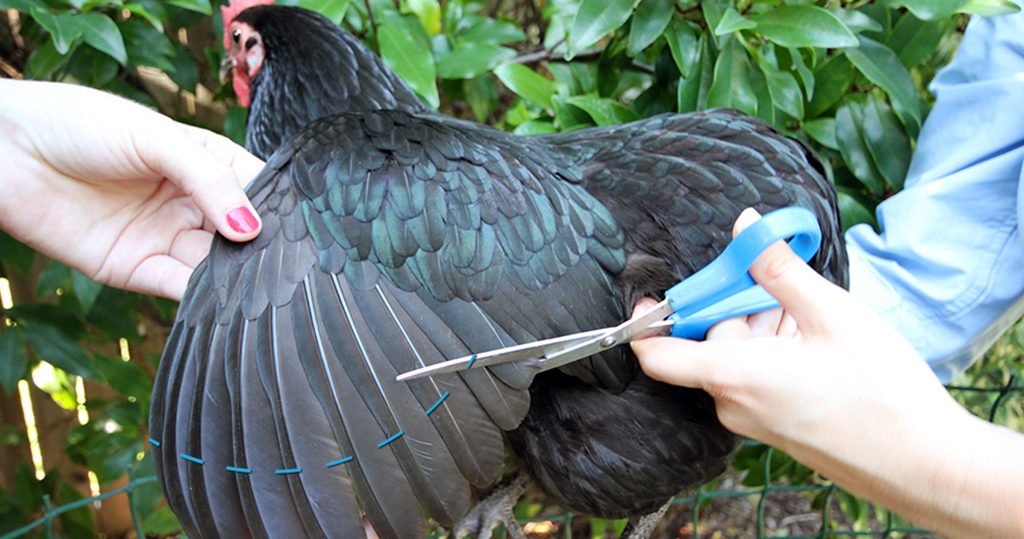
If you are worried about your birds flying the coop and taking up in your neighbor’s yard there is the option to clip their wings.
This can be done by yourself (once again if you know how and are comfortable doing so).
It is advisable to first find out how to do this or to do it under supervision as you do not want to hurt or permanently damage the bird’s wing.
Usually, only the one wing is clip this causes the bird to become unstable when it tries to take flight.
Every time the bird moults you will have to cut or have the wing cut again as the feathers grow back.
Dust baths
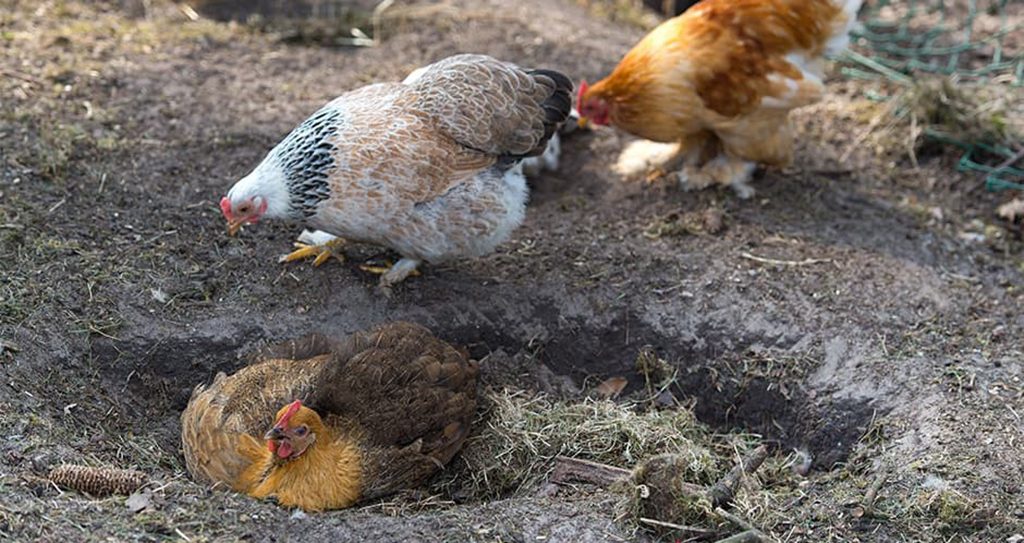
Chicken owners may find patches of dirt that looks like a chicken made a bit of a nest but in actuality, it is more likely to be a dirt bath patch. The chicken will scratch a hole to loosen up the dirt. They will then nestle in and wiggle around flapping out their wings and spewing up the dust. This is how they clean themselves in a dust bath.
The dust bath helps to remove external parasites and excess oil from their feathers and skin as well as helping to waterproof them.
Dust bathing for a chicken is what normal bathing to humans is a way to groom and get clean.
The first time you witness this you may think that your chicken is in trouble as it is quite a sight to behold.
There are many ways to make a dirt bath for you chicken and we have a few ideas for you in our “Chicken dirt baths” article. This article explains the types of sand, additives, the best dust baths for winter, etc.
It is important to ensure they have nice loose sand to fluff around in you can also add some peat moss to the pile.
Clean, snug and cozy in the cold and clean, cool and fresh in the heat
Chickens average heart rate is typically 280 to 315 beats a minute.
Their average body temperature in normal conditions should be around 102 to 103 degrees Fahrenheit.
A hen will take approximately 30 to 35 breaths per minute whilst a rooster will on average take around 18 to 20 breaths per minute.
Chickens average lifespan depends on their laying habits and can anywhere from 2 years to 20 years (this also depends on the chicken breed).
As their bodies function differently from humans and various animals they do tend to need a bit of extra care in both the hot and colder times of the year.
The hot summer months
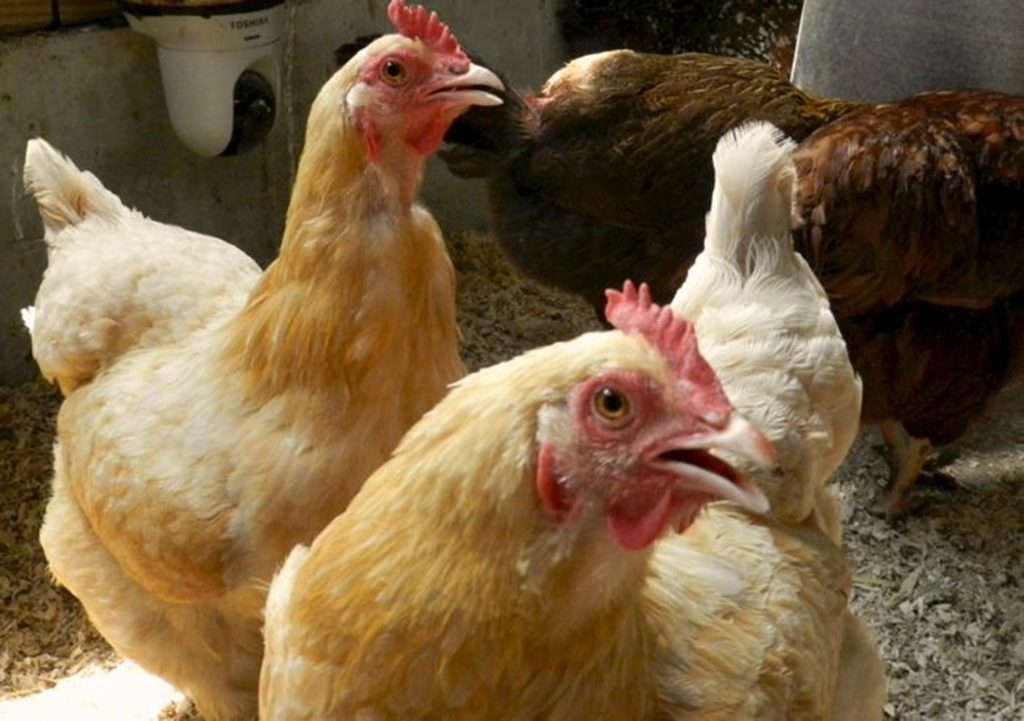
Heat has been known to cause more problems for chickens than the cold does due to their high body temperatures.
Their feathers make good insulations for them and anyone with a feather duvet knows how cozy those make one.
Chickens, as with all birds, tend to fluff out their feathers which traps air between them to help them keep warm and insulated during the cold.
When the temperatures reach 80 degrees F and above it tends to get uncomfortable for chickens and you may notice them displaying the following signs of heat stress:
They will seek out and stay mainly in the nice cool shady spots of the garden or still to the chicken coop.
Egg production will drop
They will eat less
They will drink a lot more water
Chickens tend to lay around resting more in the heat with their feathers spread out to help them cool down
When they walk around their wings may look like they are drooping down hanging by their sides. They do this to help cool them down as they cannot sweat.
Their beaks will be open more and they will pant.
Help prevent damage to your flock and keep them cool by:
Put extra bowls of water around the garden and in the coop/run
Make sure the water is in nice shady spots to keep it cool
Replace the water once to twice a day. In the summer algae tend to grow at a rapid rate so ensure you keep the bowls nice and clean.
You could even put a plastic tub out in the garden for the chickens to bath in.
Provide plenty of shady places for your chickens. You can do this by putting up simple wooden or umbrella type structures in the grand and in their run.
The coop must be well ventilated and make sure when cleaning it you check for mould which loves to grow in the summer especially if using straw and hay in the coop.
Rather use fine pine shavings in the heat as it can absorb heat whereas hay and straw tend to rot faster in the summer. You do not want it turning into nasty compost in the coop.
If you have electricity in your coop a nice gently fan will be an excellent idea.
Make ice-blocks to place in their water troughs. You can use two-litre cooldrink bottles to create ice blocks and float them in the water troughs. This provides the chickens with nice cool water during the day.
Hose off the coop during a sweltering heat in order to cool it down. Be careful not to hose too much in the run or where the chickens stand as you do not want to cause feet problems.
Add electrolytes to their water (check with your local vet for the best ones to use). When a chicken pants it changes their electrolyte, balance adding to them to their water will rebalance this and keep your chickens healthy.
Do not try and overexert them in the heat even though you may want to go and love them. Have a chat with them it is best to let them relax in the heat.
Make sure they have plenty of shady dust bathing patches to kick up sand in.
Another good way to keep them cool off is to freeze fruit and vegetable in cubes for them to peck out in the garden.
Be sure to keep the grass nice and short as long grass, weeds, reeds and shrubs can prevent air flow making the garden even hotter for your flock.
Check that your chickens have ample space in the run, coop and garden you do not want to over crown them in the heat.
The colder winter months
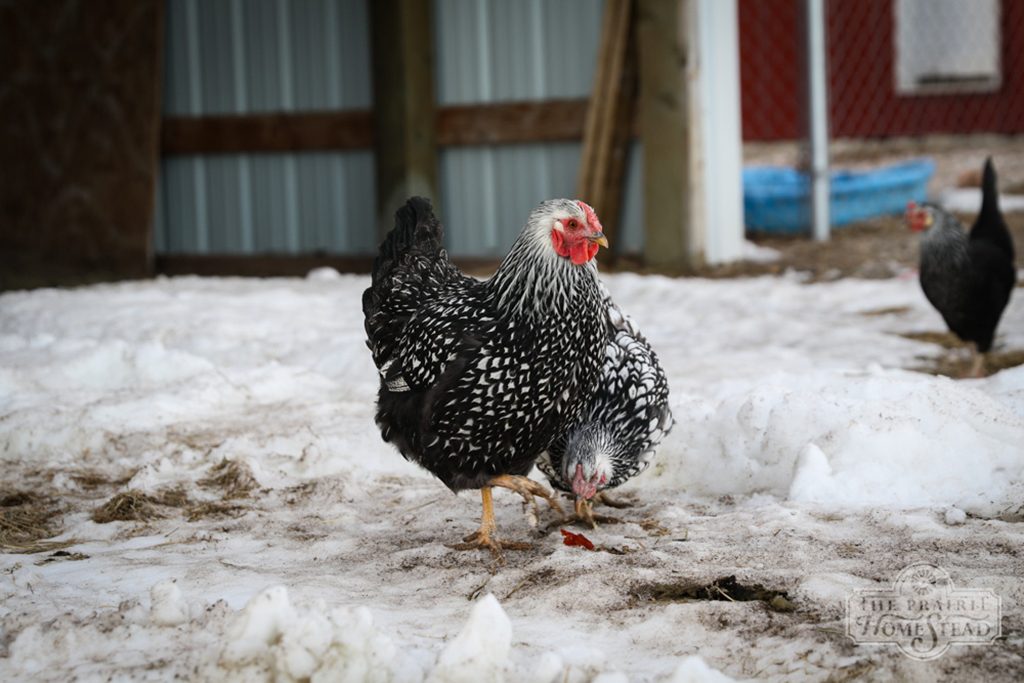
Most breeds of chickens weather the winter with no problems as their feather makes for excellent insulations. There as also some breeds of chickens that do not take to the very cold climates too well, so it is best to check on the breed to determine their weather hardiness.
Still the cold can severely affect even the hardiest of bird especially when they bed down for the night.
Watch for the following signs that your chickens are suffering from the cold weather:
Egg production will drop
The birds will huddle together in groups
There will be an increase in their appetites
They will not drink as much water
Your birds may have behavior changes
They will not be able to ward off disease as well in the cold.
They can get feet problems if they are constantly walking around in the damp
The older birds will be more affected by the cold
Some birds can suffer from frostbite
Help prevent damage to your flock and keep them warm by:
Add energy-rich fats and oils to their diets (check with your local vet for advice on this). This will also cut down on the food consumption for the birds in the cold. It provides a good source of energy to help the bird keep warm
Make sure there is not excess groundwater as the birds may just be tempted to drink from this and that could lead to worms. Especially in these cold months, it is good to ensure a rigid de-worming routine. One which you should discuss with your local vet.
Insulate their coop and keep it raised from the ground, this will keep your birds dry in the rain.
Heating lamps are a good option, but they come with their risks as well. It is always best to check these as they can be a fire hazard.
Keep a close eye on your birds for any wintery malaise in order to be able to deal with the situation early and prevent any potential outbreaks and dire consequences for your bird(s).
Keep the coop clean, sanitized and healthy for your flock.
Feeding, snacks and foraging feasts
There is a simple rule of thumb for feeding and treating your flock and it is the 90/10 rule. This is keeping to ensuring that 90% of your chicken’s daily food intake is their nutritious feed to 10% being left for tasty treats.
They have a requirement of 38 different nutrients supplied at the right levels. These are usually found in various “Complete Feeds” for chickens.
Feed your chickens in the morning before they go out to forage (every feed pack will come with instructions on the amount to feed your chickens). This way you ensure you stick to the 90/10 % rule. Chickens will get their daily nutrient requirements in their feed before they go out to peck around and forage. Foraging foods are also regarded as part of their treats.
Complete feeds come with all the supplements the bird will need. A common mistake people make is trying to supplement these feeds.
It is better to give any type of supplement as a treat instead along with the treats just ensure you are not over supplementing your bird(s). For any advice, it is best to talk to a vet, animal shelter or a poultry farmer.
Feeding your chickens:
Chickens 1 day old to 18 weeks old
Use a complete starter-grower feed.
Do not give treats until they have laid their first egg or roosters are older than 18 weeks.
Laying Hens
Laying hens need the complete 38 nutrients in their complete feed of which they should be getting at least 0.25 (half a cup) pounds of each day.
You can get various Layer feeds for birds producing table eggs.
Broiler feeds for birds producing hatching eggs.
Chickenfeed
Feed your chickens in the morning. Use Complete feeds for adults and as per above for chicks.
Scratch grains are more for a treat and should NOT be mixed with their regular food.
Ensure you provide the chicken with enough grit to help digest any grains or foods that would require it. You can get store-bought grit that is chicken size, fine gravel or a rough soil.
Oyster shells are too soft to make for good grit and you have to be careful when feeding them these. Chickens do not need too much calcium and can have an adverse effect if are overdosed on it.
Foraging
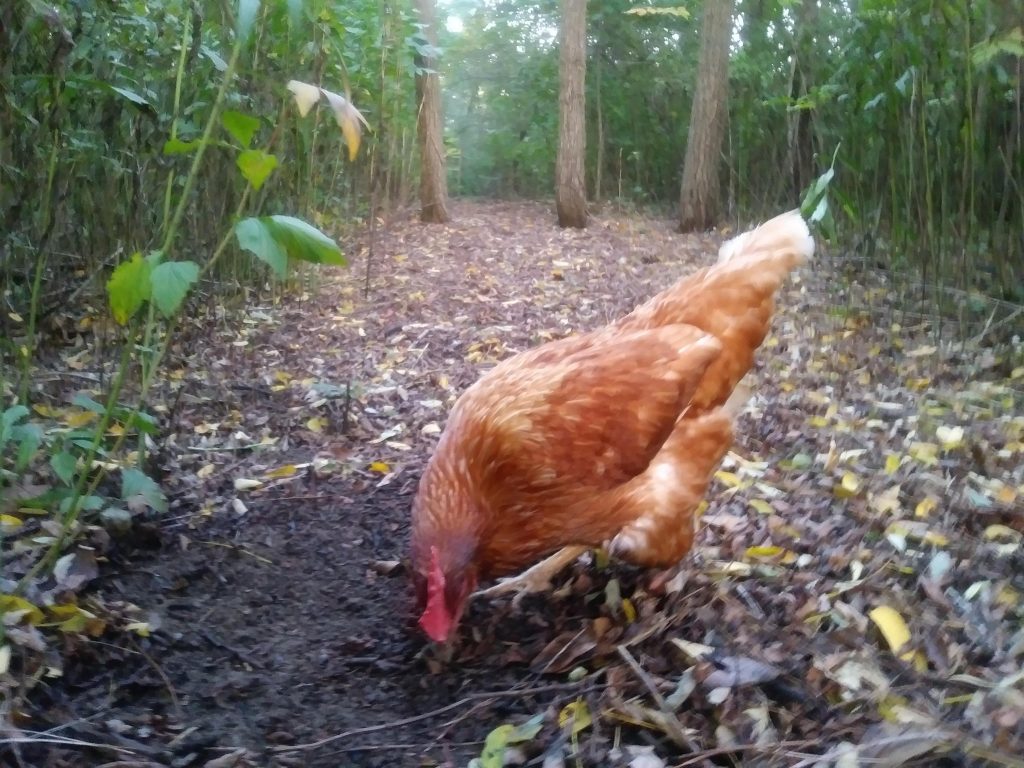
https://www.reddit.com/r/foraging/comments/9mk40y/chicken_of_the_woods_aka_my_foraging_companion/
Chickens love to forage and will try new plants and little bits they can scavage around the garden.
They are quite in tune with their bodies, so they tend not to eat what is not good for them. But there are some chickens that will eat just about anything so do take care with the kind of plants, vegetables, fruits, etc. you may have in the garden when you keep chickens.
You can throw a tablespoon or two of scratch grains around where they forage and scratch during the day. Best to do so in the afternoons.
What chickens can eat
The darker green leafy vegetables tend to give a darker egg yolk.
A few healthy favorites include:
Perennial favorites:
Roses, ferns, coneflowers, daisies, hostas and daylilies
Vegetable favorites:
Kale, swiss chard, carrots, lettuce, beets and broccoli
Fruit favorites:
Fruits should be given in moderation
Strawberries, blueberries, the flesh of an avocado and watermelon
Herb favorites:
Cilantro, thyme, basil, mint, oregano, parsley and lavender
What chickens should never eat:
The eggs chickens produce can sometimes get an odd flavor when fed certain foods. Then there are foods that contain toxins and content that can make them sick or even cause death.
Food to never feed your chickens
Avocado pits or skin contain a toxin called persin which is toxic to chickens
No mouldy or rotten foods or foods that contain a lot of salt as these may be toxic to your flock.
No meat products
Rhubarb that has severe weather exposure usually contains a high volume of oxalic acid which is toxic to chickens. Rhubarb also contains anthraquinones which have a laxative effect on your flock.
Try avoiding beans of any kind especially undercooked ones as they can contain something called hemagglutinin which acts as a digestion inhibitor.
Onions are not only bad for your flock, but they can also give their eggs a weird taste.
Garlic can be given in moderation to protect them against certain pests but keep in mind that it may impact the taste of the eggs.
Chicken friendly garden
If your birds are going to be free-ranging in your garden it is best to take care that it is a chicken-friendly garden.
Keep in mind that like the scratch up the dirt, forage about and will eat plants.
Any plants or areas you do not want them scratching about in you may want to look into putting chicken proofing in the form of tunnels or chicken wire around them. Especially if you have a vegetable or herb patch.
Keep your plants as chicken friendly as possible.
Some good old chicken time and general maintenance
Spending time with your flock every day
Chickens are really intelligent and quite sociable creatures. Most breeds will come running when they see their humans enter the garden. They also like to follow you around chatting about their day.
As with any animals they do like the attention and you should spend at least an hour or two with your flock.
Even if you just wander around your garden with them trailing behind you, give them a chat or if they enjoy it a cuddle. Check their feathers for critters and make sure they look their spritely selves.
They like to be petted on the back of their necks – gently though!
You can even play with them and teach them tricks.
It is very important to develop a trusting relationship with your bird(s).
This way they will let you handle them to check for pests, illness, grooming, etc.
General maintenance
Every Day
Feed your birds every morning before letting them roam
Give them treats in the afternoon or early evening
Collect eggs (collecting them regularly will stop them from being eaten)
Fresh food (make sure there are no droppings or foreign objects in the bowl)
Freshwater (make sure there are no droppings or foreign objects in the bowl)
Clean droppings around the coop and add fresh bedding material is required
Observe them – if you see anything unusual do a more thorough check
Once a week
Completely replace the nesting boxes and coop bedding with clean bedding
Check for critters as you go and give the area a wipe down to ensure it is fresh
Clean all the feeders and waters bowls it is always best to allow these to sun dry before filling them and putting them back.
It is a good idea to add some nice herbs to their bedding such as lavender, lemon balm and even a nice mint oil.
Give the birds a thorough checking. To do this gently pick up the hen and start with the head working your way down to their feet.
You need to check for weight loss, sores, fleas, mites, watery eyes or unusual color of their combs. There should be no scabs or a hard-swollen crop. A hen’s vent is usually moist and pink. Their legs should be smooth, not scaly and there should be no black spots. Their breast bones should not stick out this could indicate weight loss.
Once a month
Do a completely clean and disinfect the coop.
Replace all the bedding and give the nesting boxes a thorough clean.
Clean all the items in the coop such as roosts, feeders and water bowls.
Scrap any dropping away and completely clear out any stray, etc. lining the floors.
Check insulation and vents to ensure that the coop is both aired properly and insulated properly.
Replace and or fix any chicken wire that may need it as well as various items such as nesting boxes, etc. in the coop.
Every six months
De-worm the chickens
Check vaccinations
Ensure you have taken the special summer or winter precautions
Once a year
Replace any heavy equipment such as lamps, fans, the coop itself, etc. if required.
If you can have a vet check up on your flock to ensure they are healthy.
END OF PART 6
The first few months of having chickens will be the most challenging but once you get the hang of it you will not look back.
This is the end of part 6 join us for the Part 7 of our beginner’s guide where we will take a look at cockerels and roosters.
 RAISING CHICKENS – A STARTER GUIDE FOR THE FIRST-TIME CHICKEN KEEPER
RAISING CHICKENS – A STARTER GUIDE FOR THE FIRST-TIME CHICKEN KEEPER Planning and Housing a flock of chickens
Planning and Housing a flock of chickens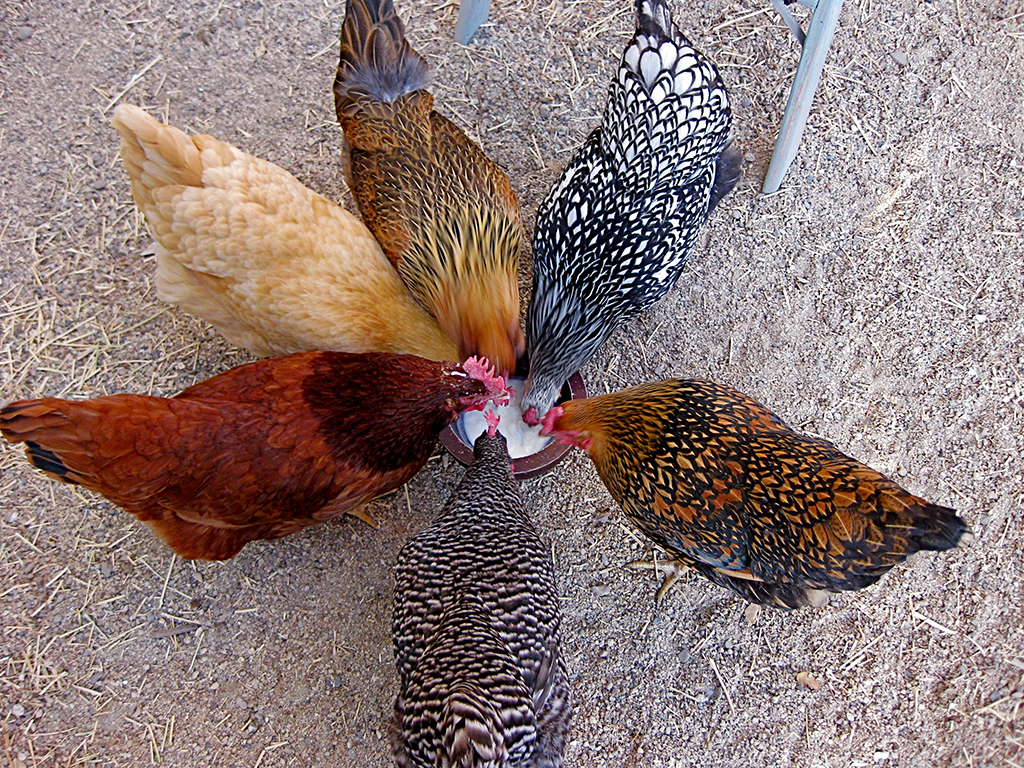 Choosing a Chicken Breed
Choosing a Chicken Breed Settling the Flock into their New Home
Settling the Flock into their New Home All about Pullets, Hens and Eggs
All about Pullets, Hens and Eggs